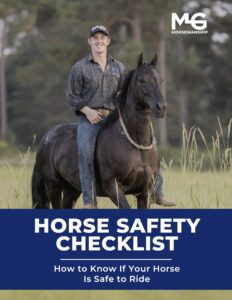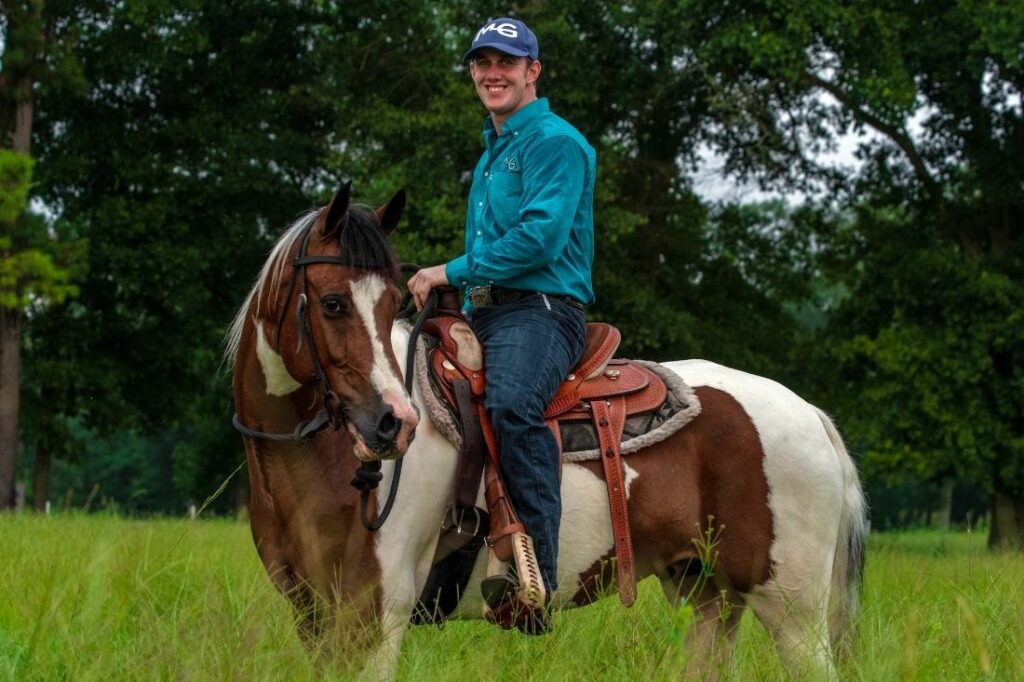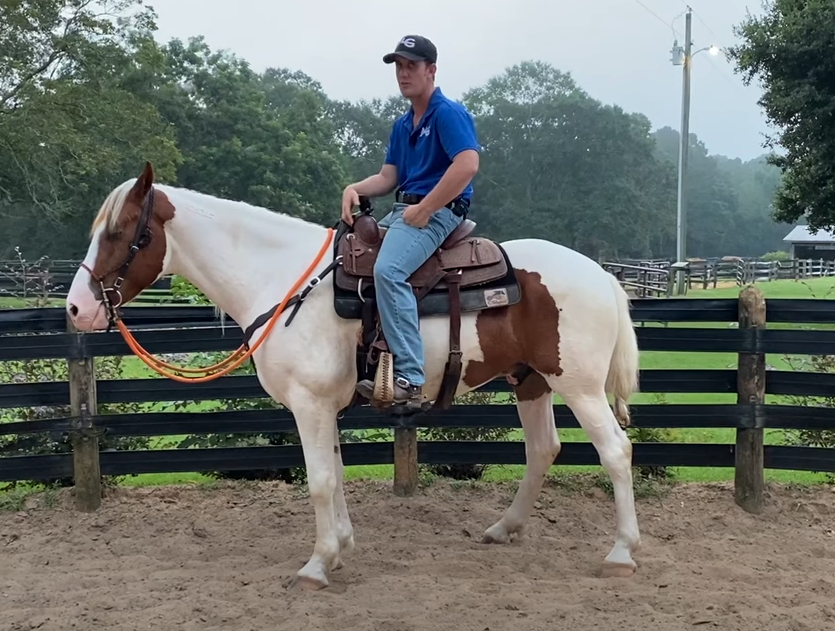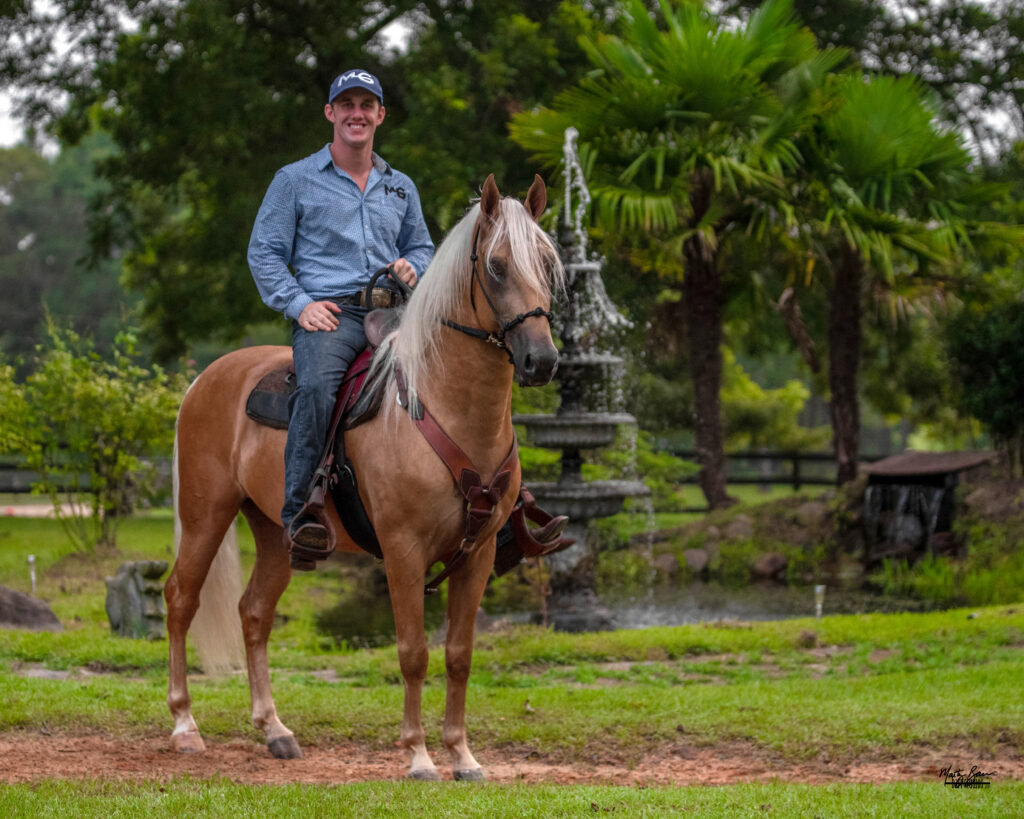Today we are talking about when, and where to use a crop while riding!
Watch the Video Here or continue reading below!
What’s going on guys it’s Michael Gascon the horse guru coming to you with the latest and greatest, when, and where, to use your crop while riding! For me personally, whenever I’m colt starting, problem horse solving, spooky horse that won’t go forward, or anything that has to do with impulsion, I do not want to use spurs. Number one, you’re stuck with them and they’re in the middle of the horse.
If I’m having an issue with the horse going forward, if I’m having an issue with the horse crossing something, if I’m going to add pressure and my legs and my kisses aren’t working. What I mean, if you pony kick your horse two times and he doesn’t flinch or even look at you, stop kicking. Now you’re just desensitizing because obviously he doesn’t care that you’re kissing to him and you’re kicking him. What I want to use is a crop as my go-to.
Start from the ground
This horse’s name is One Shot. One shot is a spotted saddle horse thug colt that just came in for training. He is a little full of himself. We will be showing you how to use a crop. I like from a two, to two and a half footer in length. Before I even get in the saddle, just like everything we do, we do it from the ground first. It doesn’t matter what bridle you have. We have a D-ring snaffle on him, but you can do this in your halter. You can do this in your curb bit. You probably wouldn’t need this on a curb bit because you’re not going use it on a horse that advanced. This horse is less than 30 days in, and he can be a little bit full of himself. A lot of times he doesn’t want to go forward.
So, what we’re going to do starting on the ground is this. We’re going to come right here and stand directly in front of him but off to the side of his shoulder and we are going to ask him to move his butt. We want to see that whenever we bring the crop to him that he crosses his back feet over just like so. We’re going to bring our rein here, pulling it up to the left, when he tries to move off, because we’re just trying to move his butt. I like to pull it up and towards where the saddle’s at because that’s where I’m going to be riding and using the crop.
Give him a warning, click to him, wave the crop, and the idea is to lighten our horse up so that our clicks hold value. Whenever we click to him, whenever we kiss to him, he thinks, Oh I better move. We’ve got one side moving, now we’re going to go to the other side.
Don’t Be Scared To Use A Crop
A lot of people are worried to use a crop on a horse that’s bucky, bolty, spooky, or reary. They’re scared that the horse is going to do that thing that they do, kick at them, or get fussy. By pulling their face off to the side, if you control the head, you control the horse. All those things, bucking, rearing, running, everything that’s not beneficial to your health, it happens in a straight line. If we can take him away from center, we can pressure him with no fear of the repercussions.
I’m going to hold this guy here and mount up.
THE POWER OF THE CIRCLE
Now again, young stud colt, a little problematic, a little full of himself. A lot of times he wants to shut down. Maybe hump up a little bit. What we want to do is make sure that he understands when we click to him, he should be going forward.
I have this crop, look at how I have it downward and in my left hand. On this side you guys can see it. For the first cropping of any horse, do not crop the horse in a straight line. If you crop him in a straight line, he can lock up the steering wheel. He could buck, run off, or do something funky. What we want to make sure that we do is that we have control of his head, and we have control of his butt. Even though he’s a stud and he’s full of himself, we cropped him from the ground, and he wasn’t able to kick us or run us over. We had him by the face. We pulled him around and we’re going do the same thing in the saddle.
I’m going to slide this right hand down the rein. Look how I’m sitting back here, heels in front of me, shoulders behind me. I’m going to sit down in the saddle, find his face, and pull him around to the right and touch his butt with the crop. Notice when I’m moving his butt that I look at the point of his hip and look how his back feet are crossing. Very good, do it again.
LET FORWARD BE THEIR IDEA
If you have a horse that doesn’t want to go forward, don’t argue with them for forward. Look to make them softer and easier in a circle. Let forward be their idea, let forward feel like freedom to them. When they hunker down instead of kicking, spurring, or whipping in a straight line where they can do something funky to you, turn them in a circle. If they put you in harm’s way, if this horse shuts down, no problem. If they don’t want to go forward on a loose rein, no problem at all.
There we go, if I click to you, I want you to go forward. If he says no, and he acts like he’s going to do something, I’ll just slide my hand down here and move his butt around very quickly. He’ll think that anytime that his face gets pulled towards his butt that he should move his butt or he’s going to get popped on the hiney.
Notice how it’s very important that I look at his butt when I want to move it. What that does is, it really twists my torso and really makes it obvious to him. Do it on one side, we can do it to the other. We give him that loose rein, we’re not trying to hold him back. Give him that loose rein, ask him to move his butt.
Pressure And Release
Don’t be afraid to pressure, I’m not pressuring him real hard because he’s already wanting to move his feet. If your horse is really stuck, if you have their face to the side, they can’t do anything with you. Give them the pressure until they move their feet and keep escalating until they’re willing to move them. The second they move their feet then release that pressure. Don’t crop them anymore. Quickly, any time that horse bulks, shuts down, or doesn’t want to go, that’s really going to make it easier for you to get that horse moving. You won’t be in jeopardy or have any fear of the repercussions.
Where to Use Your CROp
It’s difficult to change from side to side of the horse with the crop. Especially when I’m working on obstacles and things like that. We’ve already moved his butt one way and the other. Now, say you’re in a situation where you’re working on an obstacle. You’re asking him to do something, this is the rule of thumb. If you pull away from the crop, if I pull him to the right, I’ll move his shoulders with the crop like that, to the right. Then, if I turn him towards the crop to the left, then I’ll move his butt to the right.
Very quickly that young horse that doesn’t know how to go forward and is kind of looking to pick a fight with you, as opposed to going forward, you can avoid the fight. He’ll start thinking that every time the reins move that he should move. Which is true! He should be giving. He should be looking to get away from that pressure. If we do those things, it’s going to be the easiest, clearest way to get him moving, with the least amount of effort.
More importantly, not being in a stressful situation, not getting bucked around, or ran away with because he’s thinking. He’s thinking, I should give my head because if not my butt gets touched. Very quickly he gets softer and easier. The more he gives, the more you’re in control, the less he’s in control.
Turning Has The Power
Remember that a horse’s power is in a straight line. Bucking, running, rearing, all those things happen in a straight line. So, if his power is in a straight line, then our control is to the left and to the right. Using your handy dandy crop can really make it easier for you. One more time, all these colts that we work with, all these problem horses that we work, we never look for impulsion with spurs. Again, spurs are for fine tuning. Spurs are for finished riding. For a horse that already wants to take you and you’re trying to really pinpoint on what body part you want to move, and how you want him to get there.
Gain their respect
When I’m riding my young horses, my green horses, if I need aid, if I need help, not saying that I do. He showed that I could kiss at him and kick him, and he had no respect a couple weeks ago. For people, he just had an utter disregard for human beings. He would see a horse and he’d start yelling and take you there.
Well, the crop gave him a reason to listen. Then whenever I pulled on his face, if he didn’t care about that, he sure cared about whenever he got touched on the hiney. Very quickly his face softened up. He got soft and easy, and he started paying attention to me. Just him standing here calmly and quietly with a loose rein, that just lets you know where his mindset is. He just got here three weeks ago and completely changed his mind. The power of the magic stick! Try it, use it, tell me what you think. Thank you guys so much for watching this video! I’ll see you in the next one!
Check out more free training resources HERE!
HOW SAFE IS YOUR HORSE?
Can you control every part of his body, even if he’s scared or unsure?
There are some specific things that I believe every horse should be able to do before they are considered completely safe to ride. So that you can see how safe your horse is to ride, I’ve created this FREE Horse Safety Checklist.





